 Download this article in magazine layout
Download this article in magazine layout
- Share this article
- Subscribe to our newsletter
Tax or spend? What is at stake for agri-food systems transformation
The state of agri-food systems is taking centre stage in the discussions on global development priorities. The world is moving backwards on progress towards SDG2 – ending hunger, food insecurity and malnutrition in all its forms by 2030. Different driving factors have put us in reverse and off track. Conflicts, climate variability and extremes, and economic contractions – exacerbated by the Covid-19 pandemic – are major headwinds. Low productivity and inefficient food supply chains are also pushing up the cost of nutritious foods which, combined with low incomes, are making healthy diets unaffordable for billions of people. The ongoing war in Ukraine has further compounded pressure on food, fertilisers and energy prices, casting a shadow over the global state of food security and nutrition.
Against that backdrop, global economic growth prospects are inevitably being revised downward. This means that in many countries, fewer financial resources are available to support the much-needed transformation of our agri-food systems. Concurrently, existing agricultural policies and investments in the vast majority of countries are often distortive, harmful to the environment and society, and insufficiently prioritised to power agri-food systems as engines for sustainable development.
It is not surprising, therefore, that decision-makers are finding themselves caught in a policy conundrum to transform agri-food systems, particularly in lower-income countries. With the public purse under pressure and a lack of evidence on which policies and investments should be prioritised, they are at a crossroads as to which direction to take. With lower tax revenue generation commonplace, some decision-makers might well wonder if further taxing agri-food systems is a feasible option, if they are not delivering as they are on food security and nutrition fronts. Taxing agriculture or reducing subsidies is not a smart policy move when economies need stimulus. Rather than merely taxing food and agriculture for revenue generation purposes, governments should look for better ways of providing policy support to transform agri-food systems. More often than not, these avenues are close at hand.
Price support and farm subsidies dominate global agricultural policy
The food and agriculture sector benefits from, and is taxed by, governments around the world. To do that, they use various policy instruments, in particular (i) trade and market interventions (e.g. import tariffs, export restrictions, etc.), which increase or lower prices and thus provide incentives (or disincentives) to farmers and consumers; (ii) direct budget transfers (subsidies) to producers (i.e. input subsidies) and consumers; and, (iii) public investments in general services and public goods such as research or infrastructure that support rural development. According to the latest estimates, total government support to food and agriculture accounted for almost 630 billion US dollars (USD) per year globally, with roughly two-thirds of these resources benefiting farmers individually through price support (202 billion USD) and subsidies (245 billion USD) largely linked to the production of specific commodities or the use of inputs (e.g. fertiliser and seeds; see Figure below). Less than 18 per cent of total support (111 billion USD) was spent on the provision of public goods for the sector, even though this more collective form of support has stronger productivity effects in the medium to long run.
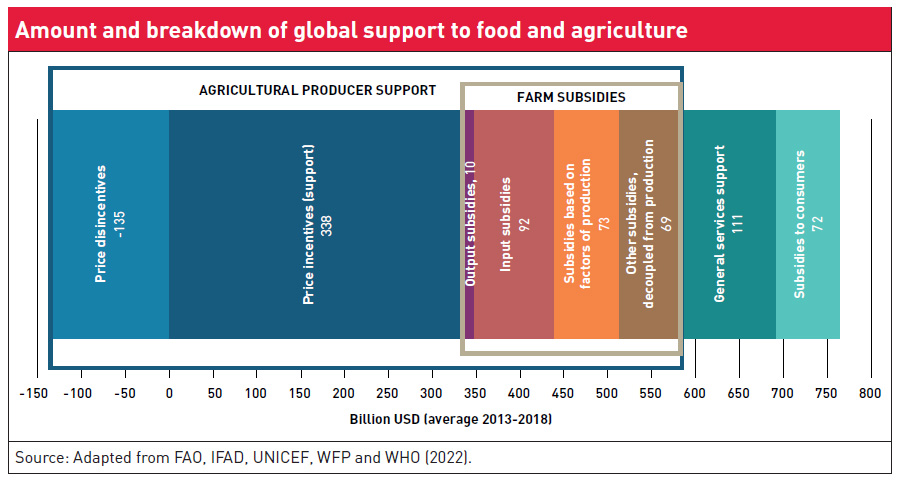
The amount and breakdown of support differ significantly across high-, middle- and low-income countries. Although agriculture in high-income countries (HICs) represents a smaller share in the overall economy, the better fiscal position of these countries allows their governments to support the sector more strongly than elsewhere (see Table). Farm subsidies in HICs make up 12.6 per cent of the total value of production, while in low-income countries (LICs) such support represents less than one per cent of the value of goods produced. Additionally, to lower food prices for consumers, LICs tend to resort to trade and market policies that penalise farmers by generating price disincentives.

Policy support is harming climate and health
Food and agricultural policies and subsidies have extensively supported farm income and pushed agricultural transformation in HICs and middle-income countries (MICs). LICs have used trade measures to protect their weak farming sectors against import competition, but also to ensure adequate supplies of food staples and access to food for consumers. However, most policy support measures around the world are, by and large, not fit to ensure that agri-food systems can sustainably deliver food security and adequate nutrition for all. A recent multi-UN agency report found that up to 87 per cent of support to farmers either distorts prices or harms nature and health. One of the main reasons lies in the fact that support to agricultural production largely concentrates on staple foods, dairy and other protein-rich foods. High greenhouse gas (GHG) emission products such as rice, sugar and meats of various types are among the most-incentivised products world-wide. On the other hand, the production of nutritious foods, such as fruits and vegetables, is less supported or even penalised in some LICs.
As a result, agricultural policies have contributed to unsustainable and harmful production practices, such as monoculture. They have also compromised nutrition and not sufficiently addressed the need to make healthy diets more affordable to all. Farm subsidies have sometimes widened income disparities, as larger agricultural producers have benefited more from subsidy schemes compared to smallholder farmers. This has led to the transformation of agri-food systems being hampered by the relatively low levels of investment in public goods, which have proven to be the most effective for boosting productivity and facilitating market access in the long term.
The time to rethink, reform and repurpose policy support is now
There is growing evidence that repurposing support to food and agriculture globally can help reshape agri-food systems and significantly improve their outcomes. According to estimates from the report The State of Food Security and Nutrition in the World 2022, reallocating existing support in ways that are designed to get consumption patterns closer to healthy dietary guidelines will, without a doubt, lower the cost of healthy diets and thus make healthy food more affordable for consumers. This will also contribute to reducing poverty and undernourishment. That said, depending on how this reallocation is done in practice, there may be trade-offs to consider in terms of farm income and GHG emissions. Others have found that investing more in climate-smart innovations that lower emissions and raise productivity could reduce land use by up to 40 per cent, while delivering gains in poverty reduction, nutrition and growth.
Designing and implementing a strategy to repurpose public support cannot be done through a one-size-fits-all approach. Successful strategies need to be evidence-based, transparent, coherent and country-specific, and require an inclusive process that takes into account the political economy of agricultural policy in each country. In several countries, steps in the right direction have already been taken, especially where price support has declined, or where subsidies have been decoupled from production, or where climate-smart and nutrition-sensitive approaches have been adopted. These are good strides, but action on repurposing needs to be bolder.
Prioritising public investments with highest value for money is key
As low-income countries and some middle-income countries have relatively less fiscal space and lower levels of policy support on food and agriculture, prioritising their public spending and investment becomes essential to ensure the best value for their public money and the highest returns of their investments. Global economic growth prospects are not bright, and the financial resources to transform agri-food systems will be even tighter in these countries.
Repurposing agriculture’s public budget to accelerate transformation
Most LICs are undergoing agricultural transformation, but still lag behind in this process. In sub-Saharan Africa, industrialisation, the main driver of past transformations, is not materialising in most countries. Not only will LICs in particular need to accelerate agricultural transformation, but they will also have to expand the supply of the nutritious and safe foods that make up healthy diets, if they are to achieve SDG2. For the governments of LICs, it will be challenging to step up the public budget to one that can carry agriculture forward and create the kind of environment that enables private investment without international development finance. Yet, closer at hand, governments could achieve better development outcomes if they simply managed and allocated their existing budget optimally.
The UN’s Food and Agriculture Organization (FAO) has developed an innovative policy optimisation tool to help policy-makers address their most common problem: dealing with multiple objectives that can be conflicting, all under a budget constraint. The tool has come up with promising results. Applied in the context of Ethiopia, for example, it considers four objectives that are key to agricultural transformation: maximising agri-food Gross Domestic Product (GDP), maximising off-farm rural employment, minimising rural poverty, and minimising the cost of a healthy diet. As shown in the Figure below, pursuing these four objectives will require prioritising the public budget differently than before. For example, it would be more effective to increase investments in irrigation, notably because that will spur the production and consumption of nutritious foods (e.g. fruits and vegetables) that are relatively more water intensive. More budget would also have to be allocated to the production of pulses (not shown in the figure), with less budget being allocated to cereals and sugar cane.
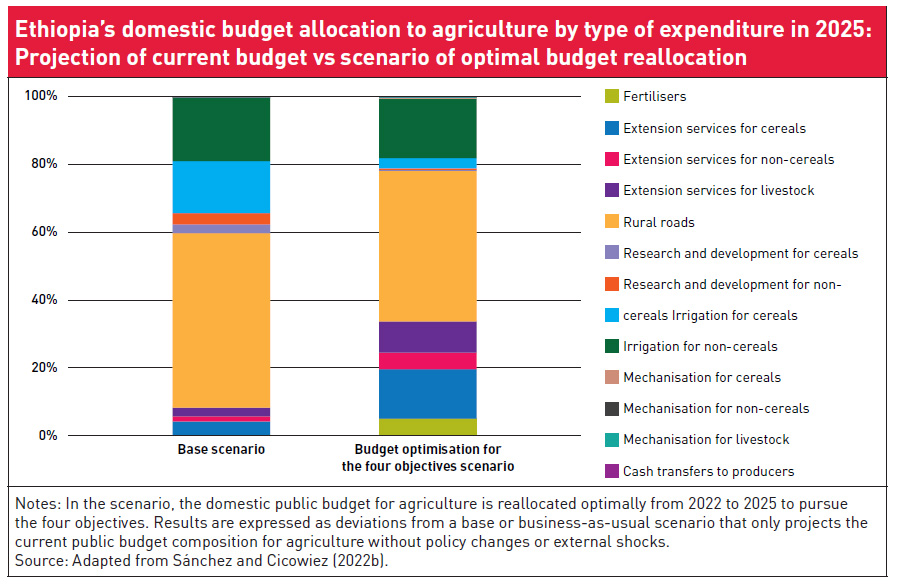
With an optimal reallocation of the public budget, we expect significant improvements on all four objectives in Ethiopia. Not only would there be higher agri-food GDP growth, but also, over 2.3 million more people would be able to afford a healthy diet, almost 500,000 jobs would be created, and 450,000 people would be out of poverty (see Figure below).
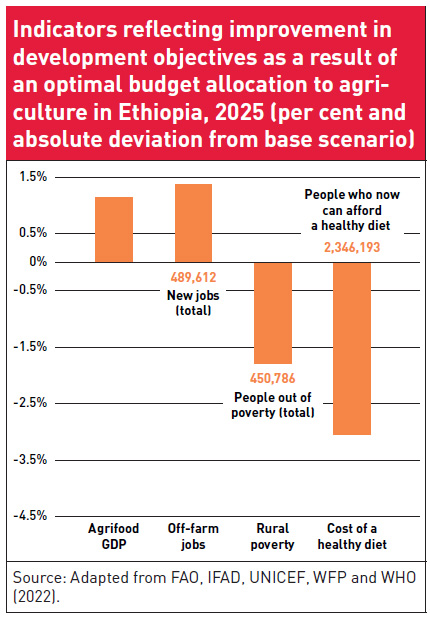
Investing little but smartly in agriculture is good for recovery and people
Agriculture, forestry and fishing remain an important driver of economic growth and employment generation in LICs and some MICs. For example, in Uganda, which is an LIC, the sector represents about 24 per cent of GDP and employs more than 64 per cent of the working population. Agriculture accounts for a much lower percentage of GDP in a country such as Mexico, an MIC, but even here, the sector employs 12 per cent of the workforce (6.5 million people). Hence, in the face of economic contraction and bleak economic prospects, it makes sense for these countries to put agriculture, forestry and fishing at the centre of their recovery efforts. Repurposing along the lines explained above for Ethiopia should of course be a first or simultaneous step to gradually scaling up public investments where they can be cost-effective economically, socially and environmentally.
In additional scenarios carried out by FAO, a modest public investment in productive infrastructure in agriculture (e.g. rural roads, irrigation systems, storage infrastructure, etc.), representing only 0.25 per cent of GDP during 2022–2024, is found to generate positive impacts – compared to a business-as-usual (or base) scenario. The resulting productivity shock and capital accumulation translate into higher rural household labour incomes, lower food prices and cheaper agricultural inputs for food processing (see Figure below). This would, in turn, result in more affordability of healthy diets. From 2022 to 2030, GDP growth and tax revenues would be a few percentage points higher, and thousands of people would have been lifted out of poverty because of such modest investment.
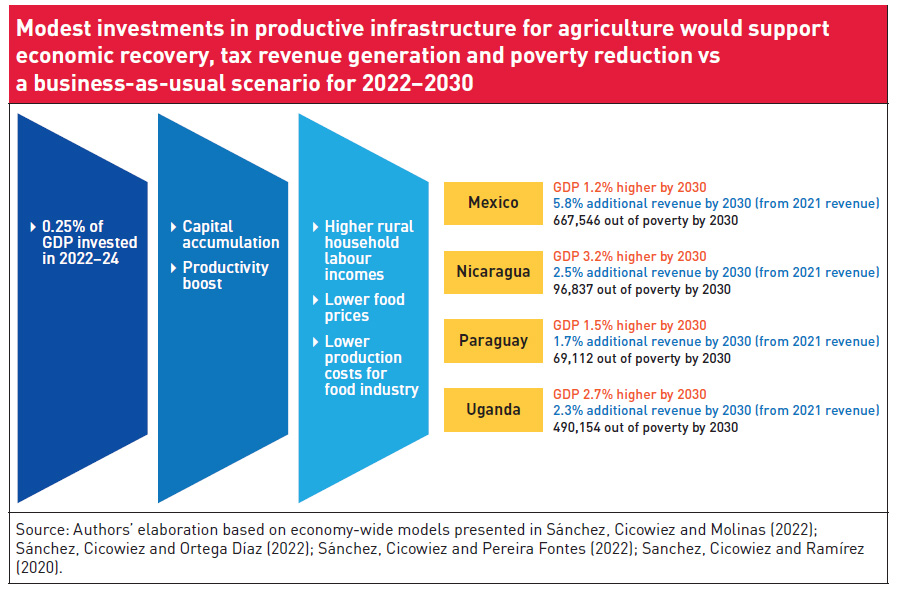
However, FAO studies also show that such modest investments in agriculture must also be prioritised across sub-sectors, as these have different impacts on household welfare, GDP, agri-food GDP and rural poverty. In the case of Uganda, for example, the sugarcane sector tops the ranking in three out of the four variables (household welfare, GDP and agri-food GDP). For the remaining variables, the cassava and potato sectors have the highest impacts on rural poverty reduction. Sectors such as cattle, bananas and goats also rank high in terms of their impacts on household welfare and GDP, but only investments in the banana sector have the potential to significantly reduce poverty. Different pictures are seen for each of the other three countries.
Irrespective of the country, there is a clear finding that is explained by how macroeconomics works. Governments in developing economies should finance new investments in agriculture with foreign borrowing or aid to speed up recovery and avert the short-term macroeconomic trade-offs of domestic financing. Raising taxes to finance new investments would reduce household consumption, whereas domestic borrowing would crowd out private investment, delaying economic recovery.
The way forward in a nutshell
As a turning point in global agri-food policy, it is clear that repurposing agricultural support towards well-prioritised policies and investments can be the key to transforming agri-food systems and enabling their capacity to deliver more food security and poverty reduction, better nutrition, and to support economic recovery. For governments, who are faced with growing fiscal constraints, better prioritisation of policies and investments is the main lever for systemic change. Individual countries, especially in sub-Saharan Africa, South Asia and Latin America, are increasingly expressing the need for sound technical assistance to help translate global diagnostics and recommendations on repurposing into actionable policy advice at national level. The examples above highlight the support that FAO is providing in this area, including through programmes such as its Monitoring and Analysing Food and Agricultural Policies (MAFAP) programme. We call on fellow development partners to join these efforts, as by working in partnerships together, we can accelerate the adoption of evidence-based policy changes to transform agri-food systems and deliver on the Agenda 2030 for people and the planet.
Marco V. Sánchez, Valentina Pernechele and Christian Derlagen work at the Agrifood Economics Division of the Food and Agriculture Organization of the United Nations (FAO), in Headquarters in Rome, Italy.
Marco V. Sánchez, Deputy Director of the division, is the lead author of this article.
Contact: marco.sanchezcantillo(at)fao.org
The authors would like to thank Martín Cicowiez for his support in running economy-wide modelling simulations and Craig Lawson and Daniela Verona for editorial support.
© FAO, 2022. The views expressed in this publication are those of the authors and do not necessarily reflect the views or policies of the Food and Agriculture Organization of the United Nations.


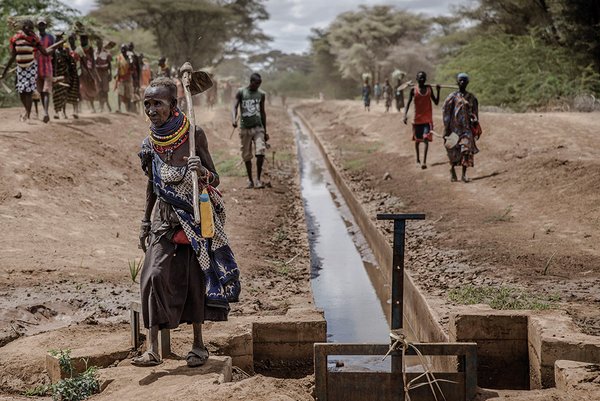


Add a comment
Be the First to Comment